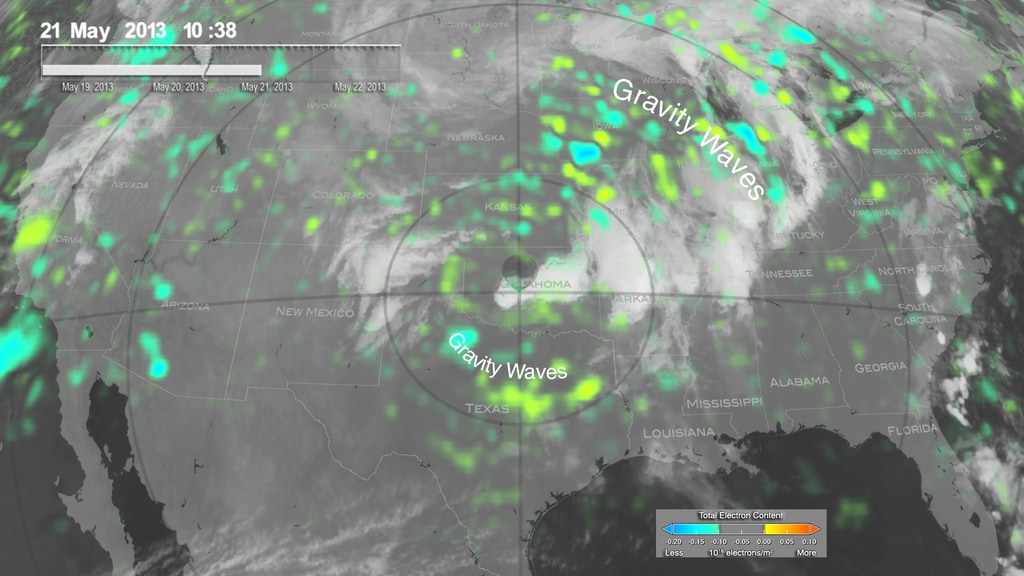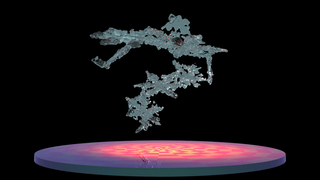Earth
Sun
ID: 4683
NASA scientists have tracked gravity waves spreading upward for hundreds of miles and outward for thousands of miles in concentric rings, like ripples in a pond. The waves were created by a large convective storm in 2013 that also spawned a deadly tornado. The visualization shows near-simultaneous measurements of the gravity waves in the troposphere, stratosphere and ionosphere.
The Atmospheric Infrared Sounder (AIRS) instrument on NASA's Aqua satellite detected gravity waves in the troposphere and stratosphere 12 hours before a deadly EF5 tornado in Moore, Oklahoma. Even stronger waves were detected 11 hours later during AIRS’ next pass. The tornado and waves were produced by a long-lived storm system.
In the ionosphere 250 miles (400 kilometers) above Earth's surface, the gravity waves appear as traveling ionospheric disturbances (TIDs) -- disturbances in the electron content of the region. These were observed in Total Electron Content measurements by ground-based GPS receivers throughout the south central United States. In the visualization, these ionospheric disturbances are shown in greens and yellows.
Gravity waves are formed when a disturbance causes air to be displaced into a region of different air density. There are many common causes for this besides storms -- for example, an air current strikes a mountain and is pushed upward. As gravity waves grow and propagate upward, they play important roles in the upper levels of the atmosphere. In the stratosphere, gravity waves help drive the atmospheric circulation and move ozone from the tropics to the poles.
Observations such as these at multiple heights in the atmosphere provide a unique perspective on how atmospheric layers are linked together. Understanding the spread of gravity waves improves global weather forecasting and space weather forecasting.



NASA Scientists see Gravity Waves in Concentric Rings
The Atmospheric Infrared Sounder (AIRS) instrument on NASA's Aqua satellite detected gravity waves in the troposphere and stratosphere 12 hours before a deadly EF5 tornado in Moore, Oklahoma. Even stronger waves were detected 11 hours later during AIRS’ next pass. The tornado and waves were produced by a long-lived storm system.
In the ionosphere 250 miles (400 kilometers) above Earth's surface, the gravity waves appear as traveling ionospheric disturbances (TIDs) -- disturbances in the electron content of the region. These were observed in Total Electron Content measurements by ground-based GPS receivers throughout the south central United States. In the visualization, these ionospheric disturbances are shown in greens and yellows.
Gravity waves are formed when a disturbance causes air to be displaced into a region of different air density. There are many common causes for this besides storms -- for example, an air current strikes a mountain and is pushed upward. As gravity waves grow and propagate upward, they play important roles in the upper levels of the atmosphere. In the stratosphere, gravity waves help drive the atmospheric circulation and move ozone from the tropics to the poles.
Observations such as these at multiple heights in the atmosphere provide a unique perspective on how atmospheric layers are linked together. Understanding the spread of gravity waves improves global weather forecasting and space weather forecasting.



Used Elsewhere In
Visualization Credits
Lori Perkins (NASA/GSFC): Lead Data Visualizer
Eric Fetzer (NASA/JPL CalTech): Scientist
Sharon Ray (NASA/JPL CalTech): Project Support
Jie Gong (USRA): Scientist
Jia Yue (University of Maryland): Scientist
S. Irfan Azeem (National Science Foundation (NSF)): Scientist
Dong Wu (NASA/GSFC): Scientist
Tom Pagano (NASA/JPL CalTech): Project Support
Carol Rasmussen (NASA/JPL CalTech): Writer
Eric Fetzer (NASA/JPL CalTech): Scientist
Sharon Ray (NASA/JPL CalTech): Project Support
Jie Gong (USRA): Scientist
Jia Yue (University of Maryland): Scientist
S. Irfan Azeem (National Science Foundation (NSF)): Scientist
Dong Wu (NASA/GSFC): Scientist
Tom Pagano (NASA/JPL CalTech): Project Support
Carol Rasmussen (NASA/JPL CalTech): Writer
Please give credit for this item to:
NASA's Scientific Visualization Studio
NASA's Scientific Visualization Studio
Science Paper:
Journal of Geophysical Research: Atmospheres "Global survey of concentric gravity waves in AIRS images and ECMWF analysis" http://onlinelibrary.wiley.com/doi/10.1002/2014JD022527
Note: While we identify the data sets used in these visualizations, we do not store any further details nor the data sets themselves on our site.
This item is part of this series:
Narrated Movies
Keywords:
DLESE >> Atmospheric science
SVS >> Solar Wind
GCMD >> Earth Science >> Atmosphere
GCMD >> Earth Science >> Atmosphere >> Atmospheric Pressure >> Gravity Wave
SVS >> Space Weather
SVS >> Hyperwall
SVS >> Solar Dynamics Observatory
SVS >> Heliophysics
NASA Science >> Earth
NASA Science >> Sun
NASA Earth Science Focus Areas >> Atmospheric Composition
GCMD keywords can be found on the Internet with the following citation: Olsen, L.M., G. Major, K. Shein, J. Scialdone, S. Ritz, T. Stevens, M. Morahan, A. Aleman, R. Vogel, S. Leicester, H. Weir, M. Meaux, S. Grebas, C.Solomon, M. Holland, T. Northcutt, R. A. Restrepo, R. Bilodeau, 2013. NASA/Global Change Master Directory (GCMD) Earth Science Keywords. Version 8.0.0.0.0
Journal of Geophysical Research: Atmospheres "Global survey of concentric gravity waves in AIRS images and ECMWF analysis" http://onlinelibrary.wiley.com/doi/10.1002/2014JD022527
"Multisensor profiling of a concentric gravity wave event propagating from the troposphere to the ionosphere". http://onlinelibrary.wiley.com/doi/10.1002/2015GL065903/abstract
Short URL to share this page:
https://svs.gsfc.nasa.gov/4683
Data Used:
NAVSTAR/World-wide GPS Receiver Network/Total Electron Content (TEC)
5/19-23/2013CPC (Climate Prediction Center) Cloud Composite
Data Compilation - Climate Prediction Center (CPC) - 5/19-23/2013
Global cloud cover from multiple satellites
Aqua/AIRS/Brigtness Temperature Variance also referred to as: Tb
Observed Data - NASA - 5/20/2013 8:30, 19:30This item is part of this series:
Narrated Movies
Keywords:
DLESE >> Atmospheric science
SVS >> Solar Wind
GCMD >> Earth Science >> Atmosphere
GCMD >> Earth Science >> Atmosphere >> Atmospheric Pressure >> Gravity Wave
SVS >> Space Weather
SVS >> Hyperwall
SVS >> Solar Dynamics Observatory
SVS >> Heliophysics
NASA Science >> Earth
NASA Science >> Sun
NASA Earth Science Focus Areas >> Atmospheric Composition
GCMD keywords can be found on the Internet with the following citation: Olsen, L.M., G. Major, K. Shein, J. Scialdone, S. Ritz, T. Stevens, M. Morahan, A. Aleman, R. Vogel, S. Leicester, H. Weir, M. Meaux, S. Grebas, C.Solomon, M. Holland, T. Northcutt, R. A. Restrepo, R. Bilodeau, 2013. NASA/Global Change Master Directory (GCMD) Earth Science Keywords. Version 8.0.0.0.0












